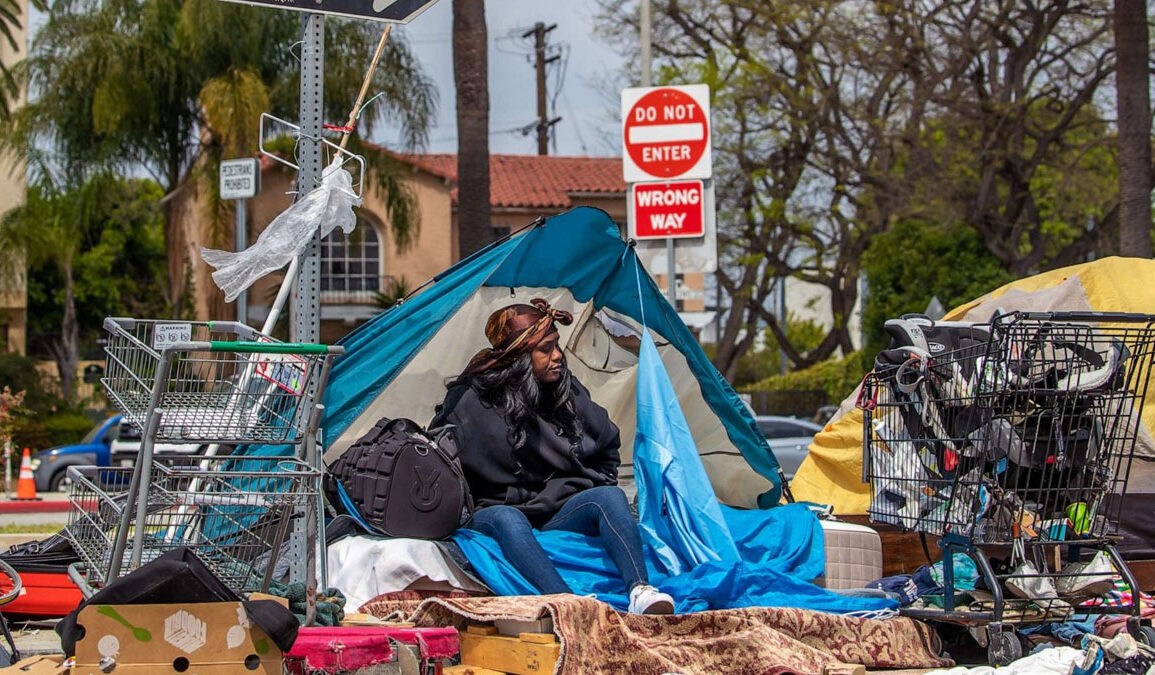Homelessness in the United States has reached unprecedented levels, with a staggering 18.1% increase recorded in 2024. According to the U.S. Department of Housing and Urban Development (HUD), over 770,000 people were counted as homeless during the January point-in-time survey—the highest number since the federal government began tracking homelessness in 2007. While the crisis is national, California stands out as both the epicenter of the problem and a symbol of failed solutions.
The Numbers Behind the Crisis
The surge in homelessness follows a 12% rise in 2023, marking two consecutive years of sharp increases. Today, approximately 23 out of every 10,000 Americans are without stable housing. The crisis disproportionately affects Black Americans, who represent 32% of the homeless population despite making up only 12% of the U.S. population.
One of the most alarming statistics is the nearly 40% surge in family homelessness. Cities like Denver, Chicago, and New York saw family homelessness more than double, driven largely by an influx of migrants seeking asylum. HUD also reported that nearly 150,000 children experienced homelessness on a single night in 2024, marking a 33% rise from the previous year.
In response to these troubling numbers, HUD Deputy Secretary Adrianne Todman stated, “No American should face homelessness, and the Biden-Harris Administration is committed to ensuring every family has access to the affordable, safe, and quality housing they deserve.” However, despite these assurances, the crisis continues to worsen.
Why is California Worse?
California accounts for nearly 30% of the nation’s homeless population, with cities like Los Angeles and San Francisco becoming synonymous with sprawling tent encampments and overwhelmed shelters. Skyrocketing housing costs, restrictive zoning laws, and bureaucratic red tape have exacerbated the crisis.
Despite spending over $20 billion on homelessness programs in the past five years, California’s efforts have largely failed to deliver meaningful results. Policies like “Housing First,” which prioritize providing housing without addressing mental health or substance abuse issues, have faced sharp criticism.
Robert Marbut, former federal homelessness coordinator, criticized the Housing First policy, saying, “This is just a horrible increase, and it shatters any myth that Housing First is working.” He further argued that migration is not the primary cause of the crisis, pointing instead to policy failures.
In Los Angeles alone, the city spent $1.2 billion on homelessness programs in 2023, yet the number of people living on the streets barely budged. Local advocates have grown frustrated, with one stating, “We’re throwing money into a black hole.” These inefficiencies and the lack of accountability in state programs have only deepened public skepticism.
The Role of Migration and Natural Disasters
Several factors have converged to drive the homelessness crisis in California. High housing costs remain a primary driver, with rents outpacing wage growth and making housing unaffordable for many. Inflation, stagnant wages, and skyrocketing construction costs have further limited affordable housing availability.
Migration has also played a role, particularly in cities like Los Angeles and San Francisco. Shelters and temporary housing facilities have been overwhelmed by asylum seekers, leaving limited resources for long-term residents facing homelessness. According to HUD, family homelessness more than doubled in 13 communities most affected by migration.
Natural disasters have added another layer of complexity. In Hawaii, for example, the devastating Maui wildfires left thousands of residents displaced and reliant on emergency shelters. On the night of the official count, more than 5,200 people in Hawaii were still staying in temporary accommodations.
Who’s to Blame?
The blame for the homelessness crisis is widely debated. Critics of President Biden argue that his administration’s border policies have exacerbated the issue by overwhelming urban shelter systems with asylum seekers. Former federal homelessness coordinator Robert Marbut pointed to the failures of the Housing First approach, claiming it neglects mental health and substance abuse treatment.
Republican lawmakers have accused Democratic leadership in California of mismanaging homelessness funds and failing to enforce policies that encourage self-sufficiency. Meanwhile, Democratic leaders argue that federal support remains insufficient and that many factors driving the crisis predate the current administration.
Adrianne Todman, HUD Secretary, pushed back against these criticisms, saying, “We are repurposing federal properties for housing, expanding housing vouchers, and advocating for zoning reform to increase affordable housing stock.” However, critics remain unconvinced, noting that these efforts have yet to produce meaningful change.
The Costs of Failure
Since 2018, California has spent over $20 billion on homelessness initiatives, including permanent housing projects, temporary shelters, and mental health services. Yet the state’s homeless population continues to grow, leaving many residents frustrated and disillusioned.
In stark contrast, cities like Dallas have managed to buck the national trend, reporting a 16% drop in homelessness by streamlining services and focusing on rapid housing placement. Former United States Interagency Council on Homelessness executive director Jeff Olivet emphasized, “What that says is that, if we keep investing the right way in getting people off the streets and into housing as quickly as possible, we really can see those numbers go down.”
Glimmers of Hope: Veteran Homelessness Declines
One bright spot in the homelessness crisis is the decline in veteran homelessness, which fell by 8% this year. This success is attributed to bipartisan support for targeted programs, housing vouchers, and mental health services tailored specifically to veterans.
Ann Oliva, CEO of the National Alliance to End Homelessness, highlighted this progress: “The reduction in veteran homelessness offers us a clear roadmap for addressing homelessness on a larger scale.”
While the Biden administration touts ongoing efforts to expand housing vouchers and reform zoning laws, critics say these measures are too slow and insufficient. On the other side, proposals from figures like Donald Trump, including tent cities and institutionalizing homeless individuals with mental health issues, remain highly controversial.
The surge in homelessness represents not just a policy failure but a humanitarian crisis. In California, the sheer scale of the problem denotes a failure in effective action. While billions have been spent, and countless promises made, the streets of cities like Los Angeles and San Francisco tell a story of systemic failure.








